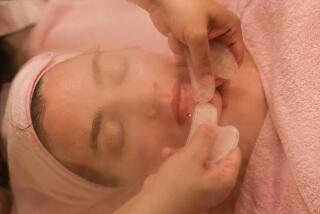Instead of a Face Lift : Peels Can Strip Years From Your Face--But You May Get Burned
SEDUCTIVE ads describe the chemical peel, a scalpel-free form of cosmetic surgery, as a quick fix for aging faces. In fact, the promise of unwrinkled skin lured more than 50,000 Americans into having the surface layers of their skin stripped last year. For most, the results were dramatic; the “new” skin looks years younger.
Unfortunately, others learned that peels can be painful, unpredictable and disappointing. Most effective on crow’s-feet, vertical lines around the mouth and crosshatches on the cheeks, a peel is no substitute for a face lift, which removes deep wrinkles and sags.
The peel is a medical procedure, usually performed under general anesthesia, using the chemical phenol to strip away the outer layers of skin. As with a severe burn, the skin blisters and forms a crust. A few days later, when the crust falls off, smoother, ultra-sensitive skin is exposed. In more aggressive peels, the face is taped, forcing the phenol to work deeper. An alternative is a lighter peel, using trichloroacetic acid. Usually an office procedure, this peel requires a painkiller rather than anesthesia and is typically effective only on fine wrinkles.
After a peel, the skin may remain red for months. It is camouflaged with opaque, sun-block makeup. Because most men won’t wear makeup, they generally are discouraged from undergoing the procedure altogether.
Dr. Melvin Spira, professor and head of the Division of Plastic Surgery at Baylor College of Medicine in Texas, says that many people are not aware that chemical peels result in enlarged pores and that skin is permanently lightened. Thus, peels are most successful on pale complexions. Individuals with olive to black skin often are left with permanent lines of demarcation between face and neck.
Peels are commonly performed around the lips successfully. But Spira cautions that sometimes the result is “excessive scarring, particularly around the mouth, an increase in fine broken blood vessels on the face and problems of extreme sensitivity.”
Many surgeons combine a peel with a face lift to improve skin texture while eliminating sags. But Spira advises against simultaneous procedures. “The peel should not be performed where the skin is lifted away from its underlying structure: the cheeks, the forehead, the jowls. The results are not consistent. A peel around the mouth is fine with a lift because that skin isn’t being lifted.”
In some cases, the absorption of phenol can cause heart irregularities. Dr. Robert Kotler, an instructor at the UCLA School of Medicine, says that because the bloodstream absorbs phenol, the procedure is not recommended for pregnant women or those with kidney problems (healthy kidneys help clear phenol from the system).
Is a chemical peel worth the risks? “Every surgery has inherent dangers,” Spira says. “So does a peel. But so far, it is the most effective method for reducing fine lines on the face.”
Model: Heather Hewitt/Cunningham Models; hair and makeup: Shelli Davies/Zenobia; stylist: Margaret Hurley
More to Read
Sign up for Essential California
The most important California stories and recommendations in your inbox every morning.
You may occasionally receive promotional content from the Los Angeles Times.









